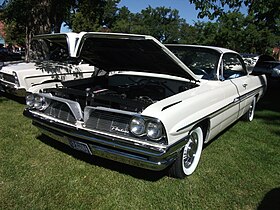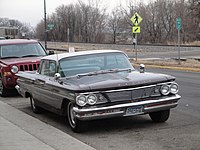Pontiac Ventura
This article's lead section may be too short to adequately summarize the key points. (April 2021) |
This article needs additional citations for verification. (July 2018) |
| Pontiac Ventura | |
|---|---|
 1960 Pontiac Ventura Vista | |
| Overview | |
| Manufacturer | Pontiac (General Motors) |
| Production | 1960–1977 |
| Assembly | Pontiac Assembly, Pontiac, Michigan |
| Body and chassis | |
| Class | Full-size (1960–1970) Compact (1971––1977) |
| Layout | FR layout |
The Pontiac Ventura was an automobile model that was produced by Pontiac. As was common practice at the time, its name was derived from Ventura, California, joining other similarly derived models such as the fellow Pontiac Catalina, the Chevrolet Malibu, and Mercury Monterey.
1960–1970 full-sized[]
| First generation | |
|---|---|
 1961 Pontiac Ventura Sports Coupe | |
| Overview | |
| Production | 1960–1961 1962–1970 (option pack for Pontiac Catalina) |
| Body and chassis | |
| Body style | 2-door hardtop coupe 4-door sedan 2-door convertible |
| Platform | B-body |
| Related | Chevrolet Impala Chevrolet Caprice Chevrolet Bel Air Pontiac Catalina Pontiac Bonneville Pontiac Parisienne Oldsmobile 88 Buick LeSabre |
| Dimensions | |
| Wheelbase | 122.0 in (3,099 mm) |
| Chronology | |
| Successor | Pontiac Catalina Brougham |
The Ventura was first introduced for 1960 as a new higher priced model on Pontiac's standard full-size 122-inch B-body wheelbase, shared with the Pontiac Catalina. It was available as the Vista (a four-door hardtop) and the Sports Coupe (a two-door hardtop).[1] It had unique exterior identification, deluxe wheel covers, a sport steering wheel, and distinctive tri-tone seats done in "Morrokide" (Pontiac's leather-like vinyl upholstery).
The Ventura continued for 1961 as a series.

1960 Pontiac Ventura Vista
Reduced to trim option[]
With the rollout of the Pontiac Grand Prix, the rationale for the existence of the Ventura as a standalone model was eliminated. The Ventura was demoted to a trim option for 1962 through 1965 on for Catalina models. It returned for 1970, it was a custom trim option on the Catalina. The name was retired at the end of the 1970 model year, as deemed for full-size cars, being transferred to a compact based on the Chevrolet Nova that was sold by Pontiac dealers through most of the mid-70s.

1971–1977 X-body compact[]
| Second generation | |
|---|---|
 1974 Pontiac Ventura 4-Door Sedan | |
| Overview | |
| Also called | Pontiac Ventura II |
| Model years | 1971–1977 |
| Assembly | Van Nuys, California |
| Body and chassis | |
| Body style | 2-door coupe 3-door hatchback 4-door sedan |
| Platform | X-body |
| Related | Chevrolet Nova Pontiac Phoenix Oldsmobile Omega Buick Apollo |
| Powertrain | |
| Engine | |
| Transmission | 2-speed automatic 3-speed manual 4-speed manual 3-speed automatic |
| Dimensions | |
| Wheelbase | 2,814 mm (110.8 in) |
| Length | 4,940 mm (194.5 in) |
| Width | 1,839 mm (72.4 in) |
| Height | 1,334 mm (52.5 in) |
| Chronology | |
| Successor | Pontiac Phoenix |
In 1971, Pontiac moved the name to their new X-body entry, the Ventura II.

Ventura II production ran from 1971 to 1977. The "II" suffix was dropped after 1972, and the Phoenix name replaced Ventura in 1978. Engine offerings for the abbreviated 1971 model year included a 250 cu in. six cylinder or 307 cu in., only the 307 was available for the Sprint option in '71. For 1972, a Pontiac-built 350 cu in. V8 with two-barrel carburetor was added to the option list and became the base V8 for 1973 and 1974. Transmission offerings consisted of a standard column-shift three-speed manual with options including a four-speed manual, two-speed automatic (with six-cylinder) or three-speed Turbo Hydra-Matic automatic (with V8s). The 1973 six-cylinder Ventura was the last Pontiac model to offer the two-speed automatic, a badge-engineered Chevrolet Powerglide, which was dropped completely from all GM cars and trucks after this model year in favor of the Turbo Hydra-Matic.

A Ventura Sprint option package was offered on two-door models 1971 to 1975, including three-speed transmission with floor shift and optional 350 cu in. V8 equipped four-speed, body color mirrors, custom carpeting, all-vinyl upholstery with either the standard bench or optional Strato bucket seats, Custom Sport steering wheel, blackout-grille trim, special striping, blackout grille, and 14x6" (36 cm diameter, 15 cm wide) wheels.
In mid-1972, Pontiac introduced the limited production Ventura SD for the Southern California market as sort of a sporty-luxury compact to counter imported luxury sedans then taking the U.S. market by storm. The SD option added the high-back Strato bucket seats from the Firebird along with a Custom Sport steering wheel, Rally II wheels, uprated suspension and other items. Some 250 Ventura SD's were built for 1972, all at the GM Nova/Ventura assembly plant in Van Nuys, California plant.
In 1973, higher spec cars received a new split grille in the Firebird/GTO style. Lower grade cars retained the split level grille used in 1971 and 1972. The Ventura Custom became a separate series (2Z, versus 2Y for the regular Ventura), carrying a "Custom" script on the rear roof pillar. In addition to the two-door coupe and four-door sedan, a three-door hatchback coupe was added to the lineup.[2]
In 1974, the Pontiac GTO name moved to the Ventura from the intermediate LeMans line. The GTO package gave the basic Ventura a 350 cu in. (5.7L) engine with a four-barrel carburetor of about 200 hp (149 kW). The package also came with a functional "shaker" hood scoop, tri-color GTO decals, Rally II wheels, and special grill-mounted driving lights. The GTO package could be ordered on the hatchback Ventura as well as the base and Custom coupes.

The GTO was dropped in 1975, along with the Pontiac 350. The Ventura could be optioned with the Buick 350 V8 instead.
The Ventura SJ was a new offering for 1975, when the Ventura and other GM compacts were restyled with new rooflines along with improved suspensions shared with the second generation F platform (Camaro/Firebird), plus standard front disc brakes. The Ventura SJ was marketed as an American rendition of a Euro-style luxury sport sedan that Pontiac created with the larger mid-sized Grand Am in 1973, as well as a competitor to the new-for-1975 Ford Granada and Mercury Monarch, both marketed as luxury compacts designed to compete with the more expensive imports such as Audi and Mercedes. As such the Ventura SJ included an upgraded interior with reclining bucket seats in either cloth or vinyl along with a center console, rally instrumentation and other items.

Only minor appearance changes were made to the Ventura for 1976 and 1977 including new grilles and revised taillights. 1976 saw the inclusion of the Oldsmobile 260 cubic inch V8. For 1977, the Chevy 250 six was replaced by Buick's 231 cu in V6 as the base powerplant and the Chevrolet 305 cubic-inch V8 was introduced as an option. The availability of the 2.5 liter "Iron Duke" 4-cylinder was optional along with the 301 cu in V8. One unique feature for 1976 was the availability of a 5-speed manual transmission (Borg Warner T-50) with the 260 cubic inch V8; it was the standard transmission with the Iron Duke. Under 700 units total with this combination were built in 1976.
At the beginning of the 1977 model year, the Ventura SJ was the top-line model but at mid-year was replaced by the Phoenix, which featured a distinctive center grille and rectangular headlights and the most luxurious interior available in a Pontiac X-body car. Otherwise, the Phoenix was basically a plushed up Ventura much like the Chevrolet Concours was related to the more mundane Nova.
For 1978, the Ventura nameplate was retired and all X-body cars were sold under the Phoenix nameplate through that year and into 1979 with a top-line Phoenix SJ designated as the top-line series.
References[]
- ^ 1960 Pontiac brochure, storm.oldcarmanualproject.com Retrieved 19 February 2018
- ^ Gunnell, John; Kowalke, Ron (2012). Standard Catalog of Pontiac, 1926-2002 (2nd ed.). Iola, WI: Krause Publications. p. 139. ISBN 978-1-4402-3234-3.
- Pontiac vehicles
- Rear-wheel-drive vehicles
- Compact cars
- Full-size vehicles
- Coupés
- Sedans
- Cars introduced in 1960
- 1970s cars
- Motor vehicles manufactured in the United States

